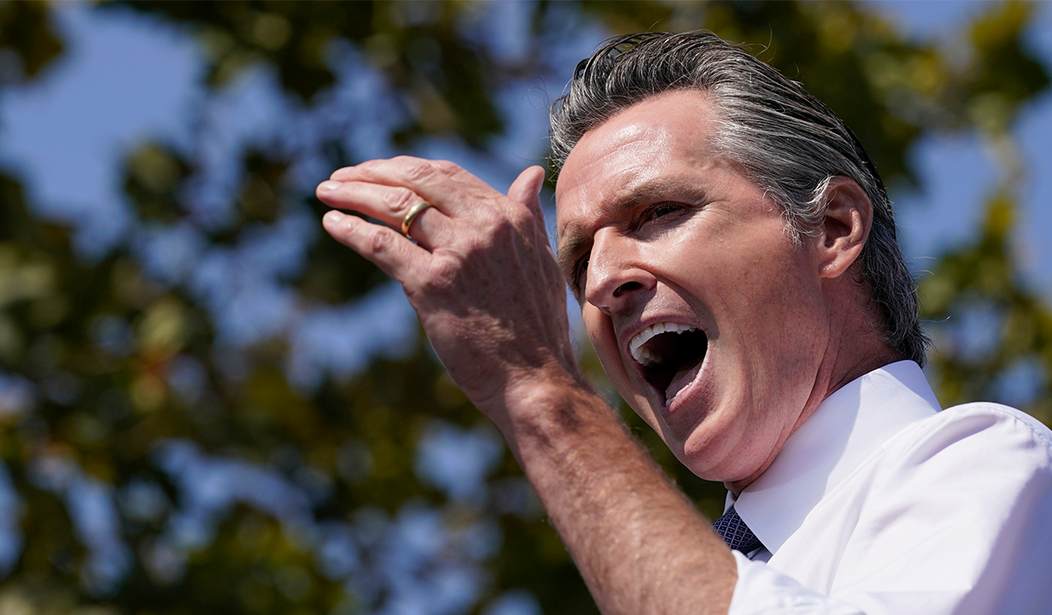California Gov. Gavin Newsom has the look these days of somebody who thinks he could be the 2024 Democratic presidential nominee, especially as the current Chief Executive, Joe Biden, continues to pile up a historic record of unmitigated failure.
At first glance, Newsom looks almost formidable, projecting something of a Kennedy-esque persona wrapped around a long record of pushing exactly the sort of Looney Left ideas one would expect of a former Mayor of San Francisco.
Add the protection of an adoring mainstream media, the seemingly endless piles of dark money from the Soros, Pritzker, Getty, and other progressive fat cat families that would be instantly at his disposal, along with millions of Democratic Party activists ready, again, to do anything necessary, legal or otherwise, to win the White House, and Newsom could be one to reckon with.
But that was before a somewhat obscure nonprofit government watchdog group delivered an explosive lesson earlier this week about the potentially incredible power of the Transparency Revolution in Government.
Meet OpenTheBooks.com (OTB) and its Founder and Chairman, Adam Andrzejewski. Odds are you aren’t familiar with them, but you likely have read more than a few news articles in recent months that were made possible by OTB’s work. Be assured that Gavin Newsom has now heard of OTB.
That’s because earlier this week, OTB announced the following facts:
- 979 vendors contributed more than $10.6 million to Newsom’s gubernatorial campaigns.
- Those same 979 vendors reaped a $6.2 billion Return-on-Investment (ROI) in the form of payments from the State of California.
- California law wisely bans “pay-for-play” deals at the local government level but inexplicably not at the state level.
Perhaps that last point explains why the current and immediate past California State Controllers swore up and down that it was impossible for them to make California’s state government checkbook available to OTB, as requested under the California Public Records Act (CPRA).
The OTB plan was to do with California’s checkbook what it has previously done for the other 49 state governments in America — post the data so every California taxpayer with a laptop and Internet access could see where Newsom and the rest of the politicians in Sacramento are spending their tax dollars.
No imagination is required to wonder why all those vendors thought it necessary to spend big bucks helping Newsom win or that deals were involved that would be highly embarrassing for all concerned, especially if they happen to be interested in the White House.
What is crystal clear is that the controllers, Betty Yee and her predecessor, John Chiang, told OTB and a California state judge that compiling all of the spending data is impossible because the state government lacks a central database.
That the state government that reaps billions of dollars of tax revenue because of the presence in its borders of Silicon Valley lacks a central spending database is hard to believe. I mean if Mark Zuckerberg can spend $400 million to get Biden elected, surely he could afford to give Sacramento a digital accounting system!
But Yee and Chiang both argued with straight faces that it would pose an “undue burden” on the controller’s staff. Beside, Yee and Chiang also told the judge, there’s really no public benefit in such transparency. Amazingly, the judge agreed with them, so OTB lost in court.
But that’s when OTB did what the politicians most feared — OTB found another way to shine the light of transparency on government spending. The nonprofit dispatched individual CPRA requests to all 461 state agencies. All but 27 education agencies responded with the requested data.
Data in hand, the OTB auditors sifted through and organized it, then built what Yee and Chiang said couldn’t be done, a California state government checkbook for its 2021 spending. And then OTB put it on the Internet.
Think about that: All 50 state governments in America have at least a year of their spending published on the Internet, thanks to OTB. And that’s not all OTB has done. If you want to know the salaries of all 2.2 million federal employees, it’s there on the OTB website, along with spending data for 15,000 municipal governments.
How does OTB do it?
“At OpenTheBooks.com, we work hard to capture and post all disclosed spending at every level of government – federal, state, and local. In 2021, we filed 47,000 Freedom of Information Act requests and successfully captured $12 trillion in public expenditures.
“We are rapidly growing our data in all 50 states down to the municipal level. We won’t stop until we capture every dime taxed and spent by our government. As a government watchdog organization, we accept no government funding.”
It’s no coincidence that OTB’s Honorary Chairman for several years was former Sen. Tom Coburn, the Oklahoma Republican who became famous as the U.S. Senate’s “Dr. No.” Coburn refused to play the Washington politicians’ game, and he demanded the facts about waste, fraud, and corruption in government. He was also willing to use every Senate prerogative at his disposal, including stopping business on the floor, if necessary.
It was Coburn’s exposure of Alaska’s infamous “Bridge to Nowhere” that prompted the end of earmarks, for almost a decade, before the pork barrel masters in both political parties shamelessly reinstated them last year.
But Coburn’s greatest achievement was one of two essential prerequisites to OTB and the Transparency Revolution. In 2006, President George W. Bush signed into law the Federal Financial Transparency and Accountability Act (FFTAA), co-sponsored by Coburn and then-Sen. Barack Obama.
Coburn-Obama’s FFTAA mandated the creation of USASpending.gov, the first-ever U.S. government website that put most federal spending on the Internet where any citizen with a computer and Internet access could find it.
Obama went on to be elected President and unfortunately, the early promise of USASpending.gov was somewhat stilted by his administration. But the essential precedent was set, and Andrzejewski was just the man to do it, beginning at the state level in Illinois.
The core concept was to combine the power of Freedom of Information (FOIA)/Public Records request to obtain spending data at all levels of government, then publish it in a manageable format on the Internet to make it available to taxpayers, interested journalists, academic researchers — everybody.
“We launched Illinois-centric with all public employees pay and pensions for the first time in history in 2011. Immediately, a Cook County school treasurer was indicted for padding his pay with up to $2 million and served time,” Andrzejewski told this author.
“Our national rollout was May 2013 at WSJ with the opEd, ‘Track Government Spending With Your Phone.’ When Dr. Coburn left the Senate; he joined us as Honorary Chairman and we gained major momentum on our national rollout.
“As you know, we have the motto, ‘Every Dime. Online. In Real Time.’ Dr. Coburn and his former staffers were instrumental in our national rollout. Many continue to play a big roll today.”
There is a small but significant backstory to all of this in which I am proud to have played a small part. In 2001, I worked at the Heritage Foundation training journalists in computer-assisted reporting, which was then a new thing in the newsroom.
Also at Heritage then was Bill Beach, now the Director of the Bureau of Labor Statistics (BLS) and then the founder and boss of the foundation’s Center for Data Analysis (CDA).
Bill and I quickly recognized we had a similar passion for making government more transparent and we figured putting official spending data on the Internet was the obvious way forward. Despite being told by an old-guard Republican federal spending “expert” that it couldn’t be done because the multiple federal spending databases could not “talk” to each other, Bill and I started informally pushing the concept.
One of the first folks to join our effort after some informal conversations was Gary Bass, then the guy behind the liberal-oriented OMB Watch newsletter who is now head of the Baumann Foundation.
Bill and I wanted the public to see how wasteful and inefficient the government is, while Gary thought the public didn’t know enough about how much good was accomplished by government.
What we all agreed on was that the public has a right to see how its tax dollars are being spent, so we had a common interest. More folks came aboard, others took on leadership roles, and it wasn’t long after that when Coburn and Obama joined forces to push for USASpending.gov.
The federal FOIA became law in 1966, but it was decades before its full potential as a tool in the Transparency Revolution began to be appreciated. It was during these same years (2001-2006) that the momentum was building for posting government spending on the Internet that I was also an FOIA advocate.
There remains so much to be done before the Transparency Revolution will be anywhere near being won, but when the history is finally written, Andrzejewski and OpenTheBooks.com will deserve a big chapter.










Join the conversation as a VIP Member